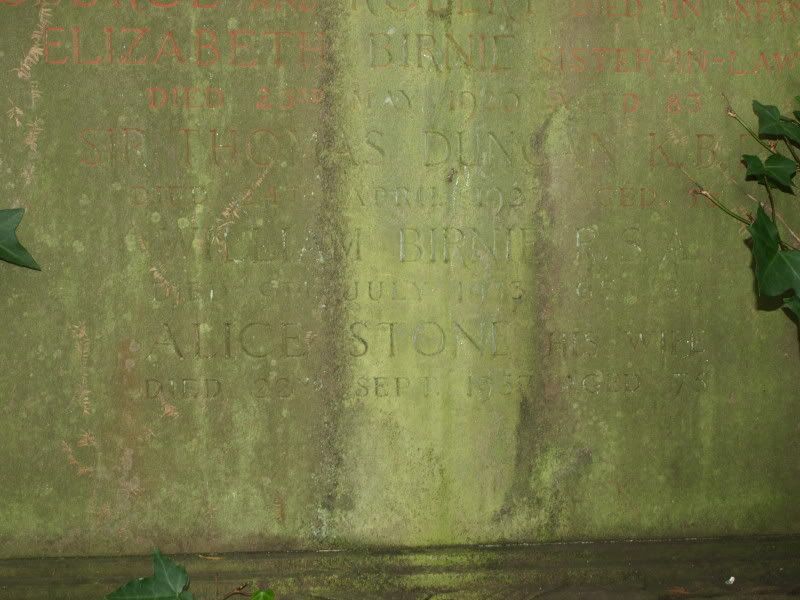 |
SMM+S
A forum to share photographs and information on Scottish Monuments, Memorials and Architectural Sculpture
|
| View previous topic :: View next topic |
| Author |
Message |
DerekR
Forum Member
Joined: 24 Jan 2009
Posts: 50
|
 Posted: Sat Jan 24, 2009 3:10 pm Post subject: William Francis Beattie (1888 - kia 1918) Posted: Sat Jan 24, 2009 3:10 pm Post subject: William Francis Beattie (1888 - kia 1918) |
 |
|
William F. Beattie, sculptor of the 1514 Memorial in Hawick, "The Horse".
William Francis Beattie was born in Hawick on the 23rd November, 1888, the only son of Thomas and Annie Kate. Thomas Beattie was an accomplished sculptor whose list of fine work included the ornate decoration incorporated into the Buccleuch Memorial Hall, the Coat of Arms from which was saved and is now built into a wall at the West Port Day Centre. Unable to obtain regular work of this stature locally, the Beattie family moved to Edinburgh where they found a modest home in Haymarket Terrace. One of his Thomas’s most notable commissions there was to create decorative work for the interior of the Usher Hall.
Displaying a natural aptitude for art inherited from his father and grandfather (one of the earliest pioneers of photography in Hawick where he combined the trades of stockingmaker and photographer), William was educated at George Watson’s College before advancing to the Edinburgh College of Art where he later became a member of staff. In his spare time, he played rugby for the Brunstane Rugby Club and was also a member of the Portobello Amateur Rowing Club. In 1910, he joined a Territorial Yeomanry Regiment, the Lothian and Border Horse, as a trooper.
Just prior to the start of the Great War, William went into business for himself as a sculptor. News of his prowess reached his old home town of Hawick from where he received a commission to design and sculpt a monument to commemorate the four hundredth anniversary of the skirmish at Hornshole in which a band of young Hawick Callants had routed a troop of English horse and stolen their flag.
June 1914 - just after the unveiling

His 1514 Memorial, erected in the Central Square, was unveiled during the Quater-Centenary week on Thursday, 4th June, 1914, by Lady Sybil Scott, daughter of the Duke of Buccleuch. The ‘Horse’ monument as it became known was widely proclaimed. Mr Peter Scott, the Managing Director of Peter Scott and Sons, hosiery manufacturers, and a leading light in the festivities, said at its unveiling to the gathered crowd that:
‘Mr Beattie had placed them under the deepest obligation by the wonderfully appropriate design of the statue, it was the inspiration of a true born Teri. In their young sculptor they had one who was a credit to his father and his native town, a Teri in spirit as well as in name.’
He went on to predict that William Beattie ‘was a young man with a great future before him and at no distant time would no doubt be one of Hawick’s most distinguished sons.’
William Beattie up the ladder on the left working on his "Horse"
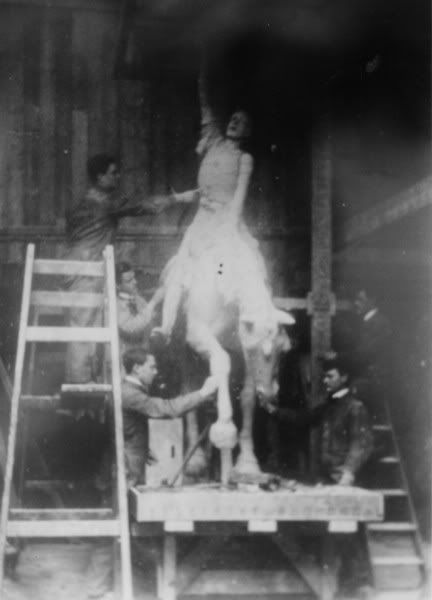
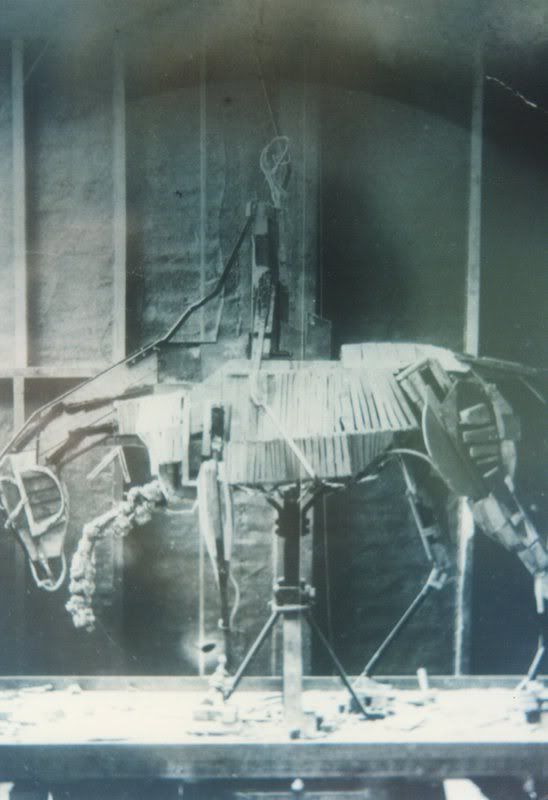
Two months after the unveiling, war broke out in Europe. Having already served for four years with the Territorial Yeomanry, William was immediately called up but like many other men in the yeomanry regiments in the country, he remained inactive at home for an intolerable length of time. It was more than a young man could stand, so William took matters into his own hands and in April, 1915, he obtained a commission in the Royal Horse Artillery and was posted on active service to France in August of that year.
In 1917, William transferred to the 73/5 Brigade of the Royal Field Artillery just prior to being awarded the Military Cross for bravery in carrying in wounded soldiers despite being under heavy shellfire. On 9th April, 1918, during the German spring offensive, he was badly gassed and as a result spent over five months convalescing back in Britain. While on sick leave, he was made a life member of Lodge St. John No.111 in his native Hawick where both his father and grandfather had been members. He made a slow but steady recovery from the effects of the gas and was declared sufficiently fit to rejoin his old unit in September, 1918. On his arrival in France, he found that his brigade had suffered such serious losses that he was given a temporary promotion from Lieutenant to Acting Major. Just two weeks later, William was fatally wounded in action and died of his wounds at a casualty clearing station at Tincourt in France on 3rd October, 1918.
When the news of his death reached Hawick, the Callants’ Club placed a laurel wreath on the ‘Horse’ memorial. On an attached card someone wrote:
‘Died of wounds, ‘somewhere’ in France, Lieutenant (Acting Major) William Francis Beattie, M.C., R.F.A., a Hawick Callant and sculptor of this memorial. In grateful remembrance of gallantry and sacrifice - the consummation of patriotism which this work of his genius ever commemorates. From the Hawick Callants’ Club.’
After the war a permanent reminder of the death of the young sculptor was inscribed on the base of the ‘Horse’. And on his headstone in France, William’s parents had a simple, but wholly appropriate and moving inscription carved:
Major W.F.Beattie M.C.
Royal Field Artillery
3rd October 1918
TERIBUS
Fate had decreed that William Beattie was never destined to become one of Hawick’s most distinguished sons as Mr Peter Scott had predicted. Instead, William joined the ranks of the great fallen in that doomed generation. During his short life he had shown considerable aptitude as a sculptor but sadly his great potential was never to be fulfilled. In death, his ‘Horse’ monument became both a commemoration of Hawick’s old victory and a symbol of our more recent loss. It is a contradiction, a celebration of the perceived pre-1914 view of war as being honourable and glorious set against the realisation that there is no greater folly known to man than war.
I'd be very interested in anyone who can add anything to William's story. |
|
| Back to top |
|
 |
DerekR
Forum Member
Joined: 24 Jan 2009
Posts: 50
|
 Posted: Sat Jan 24, 2009 3:12 pm Post subject: Posted: Sat Jan 24, 2009 3:12 pm Post subject: |
 |
|
Source: Watsonian War Record. 1914-1918.
William Francis Beattie, RFA
Born at Hawick in 1886, the only son of Mr. T. Beattie, sculptor, Edinburgh
Entered George Watson's College in 1902
"He developed a taste for art, and, as a student at the Art College, gave high promise of future distinction by his equestrian statue in bronze - the Hawick 1514 Memorial.
Played in the Lismore and Brustane XVs.
At the beginning of the war he enlisted in the Border and Lothian Horse
Gazetted as a 2nd Lieutenant in the RHA in April 1915
Promoted to Lieutenant in the RFA in July 1917
Appointed as an Acting Captain in October 1917 and as an Acting Major in April 1918
"He had meantime gone through some of the stiffest fighting in France, had been at Ypres, Loos and the Somme, been gassed, and had won the MC in November 1917."
Died of wounds at Joncourt, north of Peronne, Oct 3, 1918.
Beattie's MC was gazetted in the London Gazette of 26 November 1917 and his citation for the award appeared in the London Gazette of 6 April 1918.
His citation is as follows:
"For conspicuous gallantry and devotion to duty. The neighbourhood of his battery was heavily shelled, and he heard cries for help coming from a track about 80 yards away. He at once went to the spot with some men and a stretcher, under heavy fire and brought two men under cover." |
|
| Back to top |
|
 |
DerekR
Forum Member
Joined: 24 Jan 2009
Posts: 50
|
 Posted: Sat Jan 24, 2009 3:13 pm Post subject: Posted: Sat Jan 24, 2009 3:13 pm Post subject: |
 |
|
They say that every picture tells a story:
William Beattie as a civilian sculptor of great promise in 1914
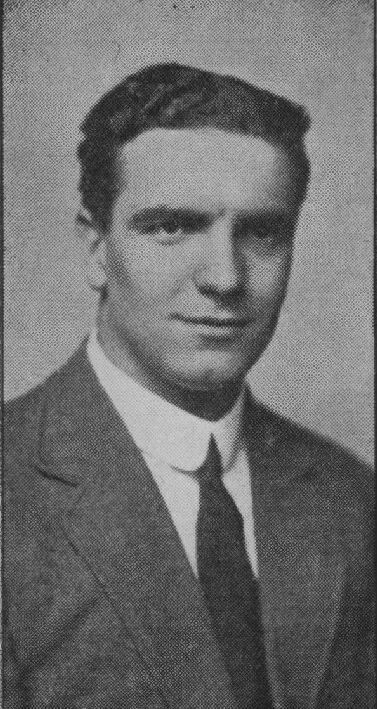
As a soldier @ 1916

A dreadfully thin and sick looking William Beattie in early 1918
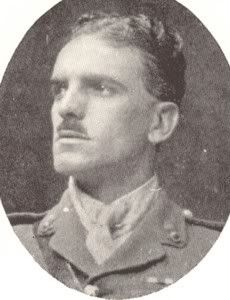
And the saddest picture of them all:
 |
|
| Back to top |
|
 |
DerekR
Forum Member
Joined: 24 Jan 2009
Posts: 50
|
 Posted: Sat Jan 24, 2009 3:15 pm Post subject: Posted: Sat Jan 24, 2009 3:15 pm Post subject: |
 |
|
The unveiling of the 1514 Memorial in June 1914 - the "calm before the storm"
 |
|
| Back to top |
|
 |
DerekR
Forum Member
Joined: 24 Jan 2009
Posts: 50
|
 Posted: Sat Jan 24, 2009 3:16 pm Post subject: Posted: Sat Jan 24, 2009 3:16 pm Post subject: |
 |
|
Andy Pay investigated William's military career for me and in his service record I found a letter signed by a Duncan Rhind which was sent to Thomas Beattie in 1919.
The letter began "My dear Beattie" so there was obviously a connection between the two. The letter was stamped with a Ministry of Pensions mark and ended with the line "I have as you say got a good job here in the meantime, but I am anxious to get back to my profession, when it is ready to come back to me. When that will be goodness knows"
It is very interesting that someone with the surname of Rhind know the Beattie's personaly.
Would Duncan Rhind be one of the sculptor clan?

As an aside, Thomas Beattie's studio was at 109 Haymarket Terrace in Edinburgh. |
|
| Back to top |
|
 |
Adam Brown
Forum Admin
Joined: 25 Nov 2008
Posts: 415
Location: Edinburgh
|
|
| Back to top |
|
 |
|
|
You cannot post new topics in this forum
You cannot reply to topics in this forum
You cannot edit your posts in this forum
You cannot delete your posts in this forum
You cannot vote in polls in this forum
|
|












